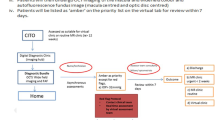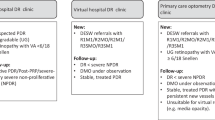Abstract
Background
To describe the clinical outcomes following implementation of a high-volume medical retina virtual clinic utilising a diagnostic hub.
Methods
Retrospective consecutive case-series of all patients attending the medical retina virtual clinics at Moorfields Eye Hospital (City Road) for 6 weeks from September 21, 2020.
Results
In 6 weeks, 1006 patients attended the medical retina virtual clinics, which included an appointment in the diagnostic hub followed by an assessment asynchronously the following working day. The vast majority of patients were follow-up attendances (969, 96.3%) with much fewer new patient attendances (37, 3.7%). The most common diagnoses made overall were diabetic retinopathy (457, 45.4%), age-related macular degeneration (208, 20.7%) and retinal vein occlusion (80, 8.0%). The majority of patient (643, 63.9%) outcomes were follow-up in the medical retina virtual clinics including 313 (31.1%) with OCT-only pathway and 330 (32.8%) with OCT and widefield fundus imaging. Routine follow-up requested after virtual assessment included 320 (31.8%) with a 3–4 month review and 267 (26.5%) with a 6 months assessment. Only 62 patients (6.2%) were asked to return for face-to-face assessment within 2 weeks.
Conclusions
We describe a new high-volume medical retina virtual clinic utilising a diagnostic hub in which more than 1000 patients were seen and assessed asynchronously. Most patients were assessed as suitable for routine follow-up in this virtual pathway and only a small proportion required urgent reviews (within 2 weeks). In the COVID-19 era, this form of high-volume virtual clinic has the potential to review patients efficiently and safely.
Similar content being viewed by others
Log in or create a free account to read this content
Gain free access to this article, as well as selected content from this journal and more on nature.com
or
References
Kotecha A, Brookes J, Foster PJ. A technician-delivered ‘virtual clinic’ for triaging low-risk glaucoma referrals. Eye (Lond). 2017;31:899–905.
Ratnarajan G, Kean J, French K, Parker M, Bourne R. The false negative rate and the role for virtual review in a nationally evaluated glaucoma referral refinement scheme. Ophthalmic Physiol Opt. 2015;35:577–81.
Scanlon PH. The english national screening programme for diabetic retinopathy 2003–016. Acta Diabetol. 2017;54:515–25.
Tsaousis KT, Empeslidis T, Konidaris VE, Kapoor B, Deane J. The concept of virtual clinics in monitoring patients with age-related macular degeneration. Acta Ophthalmol. 2016;94:e353–355.
Kern C, Kortuem K, Hamilton R, Fasolo S, Cai Y, Balaskas K, et al. Clinical outcomes of a hospital-based teleophthalmology service: what happens to patients in a virtual clinic? Ophthalmol Retin. 2019;3:422–8.
Royal College of Ophthalmologists. The way forward. Age-Related Macular Degeneration and Diabetic Retinopathy. Royal College of Ophthalmologists, London, UK; 2015.
Keane PA, Liakopoulos S, Jivrajka RV, Chang KT, Alasil T, Walsh AC, et al. Evaluation of optical coherence tomography retinal thickness parameters for use in clinical trials for neovascular age-related macular degeneration. Invest Ophthalmol Vis Sci. 2009;50:3378–85.
Zur D, Iglicki M, Busch C, Invernizzi A, Mariussi M, Loewenstein A. OCT biomarkers as functional outcome predictors in diabetic macular edema treated with dexamethasone implant. Ophthalmology. 2018;125:267–75.
de Boer JF, Cense B, Park BH, Pierce MC, Tearney GJ, Bouma BE. Improved signal-to-noise ratio in spectral-domain compared with time-domain optical coherence tomography. Opt Lett. 2003;28:2067–9.
Kiss S, Berenberg TL. Ultra widefield fundus imaging for diabetic retinopathy. Curr Diab Rep. 2014;14:514.
Lim WS, Grimaldi G, Nicholson L, Basheer K, Rajendram R. Widefield imaging with Clarus fundus camera vs slit lamp fundus examination in assessing patients referred from the National Health Service diabetic retinopathy screening programme. Eye (Lond). 2021;35:299–306.
Lee JX, Manjunath V, Talks SJ. Expanding the role of medical retina virtual clinics using multimodal ultra-widefield and optical coherence tomography imaging. Clin Ophthalmol. 2018;12:2337–45.
Kortuem K, Fasler K, Charnley A, Khambati H, Fasolo S, Katz M, et al. Implementation of medical retina virtual clinics in a tertiary eye care referral centre. Br J Ophthalmol. 2018;102:1391–5.
Royal College of Ophthalmologists. Guidance on restarting Medical Retina Services. Royal College of Ophthalmologists, London, UK; 2020.
Group AHSR, Chew EY, Clemons TE, Bressler SB, Elman MJ, Danis RP, et al. Randomized trial of a home monitoring system for early detection of choroidal neovascularization home monitoring of the Eye (HOME) study. Ophthalmology. 2014;121:535–44.
Ward E, Wickens RA, O’Connell A, Culliford LA, Rogers CA, Gidman EA, et al. Monitoring for neovascular age-related macular degeneration (AMD) reactivation at home: the MONARCH study. Eye (Lond). 2021;35:592–600.
Schmid MK, Thiel MA, Lienhard K, Schlingemann RO, Faes L, Bachmann LM. Reliability and diagnostic performance of a novel mobile app for hyperacuity self-monitoring in patients with age-related macular degeneration. Eye (Lond). 2019;33:1584–9.
Acknowledgements
Funding:
The authors declare no funding support or sponsorship for this study
The Moorfields Medial Retina Virtual Assessment Study Group
Peter KF Addison1, Sobha Sivaprasad1, Deepthy Menon1, Barsha Sarma1, Virinder Dhillon1, Najiha Rahman1, Rajasudha Sawri-rajan1, Lucia Finocchio1, Panteleimon Fotiou1, Ricardo Romero Fontenlos1, Sandra Vermeirsch1, Aditi Agarwal1, Hagar Khalid1, Janice Roth1, Supawat Trepatchayakom1, Maria Pilar Martin-Gutierrez1, Marcela Bohn De Albuquerque Alves1, Katarina Hurtikova1, Dana Ahnood1, Nashila Hirji1, Rajna Rasheed1, Eleftherios Agorogiannis1, Ling Zhi Heng1, Sofia Ajamil1, Assaf Rozenberg1, Stacey Strong1, Bahar Demir1, Carlos Valdes Lara1, Cristina Arpa1, Saqlain Sadiq1, Konstantinos Bouras1, Alexandra Hoeh1, Gabriela Grimaldi1, Karla Orsine Murta Dias1, Bejal Shah1, Senthil Selvam1, Daren Hanumunthadu1, Elizabeth Yang1, Karen Wong1, Charles Hennings1, Rohan Hussain1, Malgorzata Woronkowicz1
Author information
Authors and Affiliations
Consortia
Contributions
LN and DH designed the study, collected the study data, completed the analysis and wrote the manuscript; LN also provided critical appraisal of the manuscript. KT, KB, RH and KA designed the study and provided critical appraisal of the manuscript. The Moorfields Medical Retina Virtual Assessment Study Group helped collect study data
Corresponding author
Ethics declarations
Conflict of interest
The authors declare no competing interests.
Additional information
Publisher’s note Springer Nature remains neutral with regard to jurisdictional claims in published maps and institutional affiliations.
Members of the The Moorfields Medical Retina Virtual Assessment Study Group are listed below Acknowledgements.
Supplementary information
Rights and permissions
About this article
Cite this article
Hanumunthadu, D., Adan, K., Tinkler, K. et al. Outcomes following implementation of a high-volume medical retina virtual clinic utilising a diagnostic hub during COVID-19. Eye 36, 627–633 (2022). https://doi.org/10.1038/s41433-021-01510-4
Received:
Revised:
Accepted:
Published:
Issue date:
DOI: https://doi.org/10.1038/s41433-021-01510-4
This article is cited by
-
Virtual vitreoretinal clinics: a service delivery pathway of the future
International Journal of Retina and Vitreous (2025)
-
A pathway-driven approach to high-volume digital medical retina clinics
Eye (2025)
-
Telemedicine in ophthalmology
Wiener Medizinische Wochenschrift (2025)
-
The digital age in retinal practice
International Journal of Retina and Vitreous (2024)
-
Telemedicine: outcomes of a hybrid vitreoretinal service, from pilot to practice
Eye (2024)



